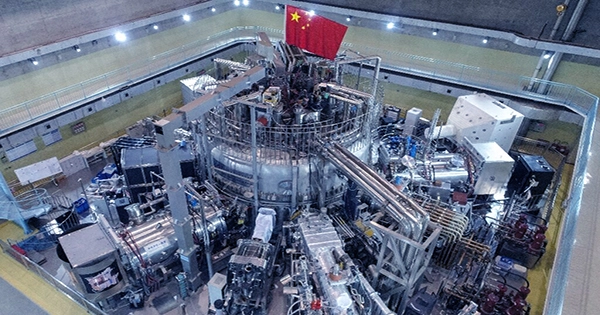China’s nuclear fusion reactors continue to make significant progress toward achieving controlled and limitless energy output. On December 30, the Experimental Advanced Superconducting Tokamak (EAST) broke its own record of 1,056 seconds by keeping plasma at 120 million degrees Celsius (216 million degrees Fahrenheit) for an astonishing 1,056 seconds. This the longest time high-temperature plasma has been confined, according to the Chinese Academy of Sciences’ Institute of Plasma Physics (ASIPP).
It was also a tremendous accomplishment for the reactor. The previous record was set in May when the reactor maintained a temperature of 120 million degrees Celsius for 101 seconds. The reactor has previously reached higher temperatures, but only for a short period. In May, plasma was created at a temperature of 160 million degrees Celsius for 20 seconds.

Those are tremendous temperatures. To give you an idea of how hot they are, the Sun’s core, where hydrogen fusion takes place, is 15 million degrees Celsius (27 million degrees Fahrenheit). These reactors can withstand temperatures that at least six times higher. In fact, in fusion, the key figure is 100 million degrees Celsius. To make fusion happen on Earth, that is what has required in reactors. Incredible pressures keep hydrogen confined to the Sun’s core, allowing for lower temperatures.
Because nuclear fusion reactors lack the ability to generate those pressures, they rely on strong magnetic fields to hold the plasma together and allow it to fuse into heavier elements. The fusion process produces enormous amounts of energy, which researchers want to extract and convert into power. The tokamak is one of two common designs for nuclear fusion reactors, with the stellarator being the other. A tokamak resembles a large empty donut (technically speaking a torus). Plasma containing deuterium and tritium (a kind of hydrogen with additional neutrons) is pumped into the doughnut and held in place magnetic fields. It becomes superheated and starts to fuse, releasing energy.
That is a simplistic description, and it does not do honor to the vast and difficult work of accomplishing these milestones. Every part of nuclear fusion in the lab has been a tremendous engineering achievement, and there is still much more work to do before self-sustaining nuclear power plants become a reality.
“ASIPP has a fantastic group of people. No matter how bad the situation is, we will overcome it!” ASIPP Director-General Professor Yuntao Song said in a statement. EAST’s work will be critical in informing the operation of ITER, a worldwide partnership supported by the European Union with contributions from China, India, Japan, South Korea, Russia, and the United States. ITER is a full-scale nuclear fusion reactor whose purpose is to test technology that will employ in commercial facilities in the future.
















